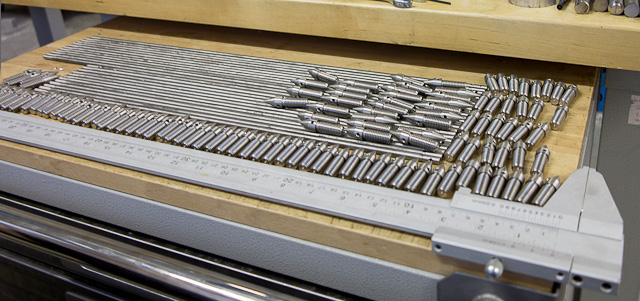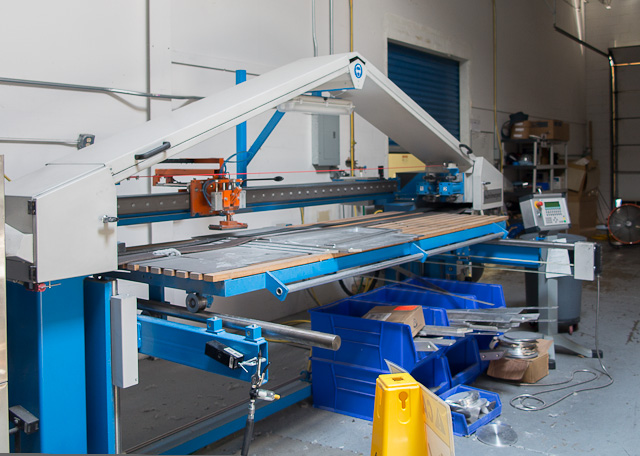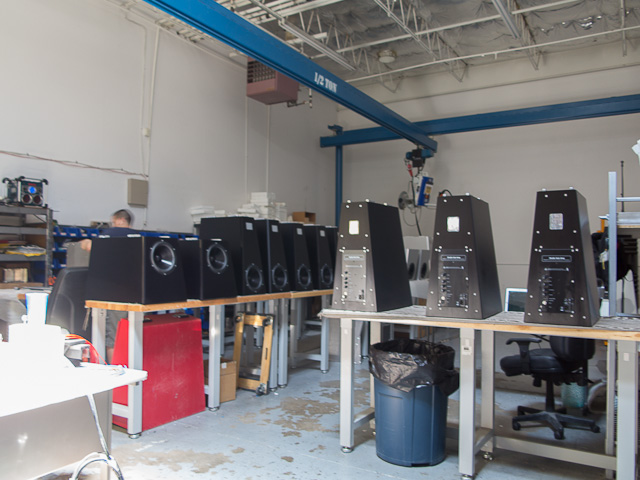Twenty years ago I owned Thiel speakers. Being a typical obsessive-compulsive audiophile, I thought I heard something wrong with one of the speakers. Thiel’s manufacturing’s facility is located in Lexington, Kentucky, about 200 miles from my home in Nashville, so I called them and asked if I could bring my speakers up to have them tested to see if anything was amiss. They were very accommodating, and invited me up for a tour of the factory while they were checking them out.
Three hours later I arrived at a small industrial park and pulled around back to unload my speakers. Up went the overhead door and what did I see: stacks of MDF, rolls of veneer, table saws, an overhead vacuum system to deal with sawdust, half completed speaker cabinets held together with clamps, and a special area to spray on varnish. In short, a furniture factory. There is no question that Thiel makes some beautiful speaker cabinets, but where was the technology area? There was a small room where Jim Thiel at the time was working on his latest concentric midrange-tweeter drivers. There was also a modest listening room and some office space.
Fast forward twenty years. That is still how a majority of speakers are made: cabinet shops using off-the-shelf speaker drivers with crossovers designed using LEAP and other readily available software, and relying on wood bracing to control resonance, in many cases charging exorbitant prices. However, there are a few companies in the forefront using state of the art materials and drivers, like Wilson Benesch, which uses carbon fiber for its cabinet shell, Wilson Audio with its X-material for cabinet construction, and Magico, which uses nanotechnology for its woofer and midrange drivers and has recently shifted from Baltic birch to aluminum cabinets for its Q series. Then there is YG Acoustics, brainchild of Yoav Geva, who for the past ten years has been leading the way with its unique use of aluminum for virtually every non-electronic part in its speakers, including both cabinets and drivers. Why aluminum you may ask? It’s simple: it is lightweight, strong, extremely stiff, non-resonant and - with the right machines - can be fabricated into any shape imaginable.
You can imagine how excited I was when Yoav Geva invited me out to Arvada, Colorado, just outside of Denver, for a factory tour. To maximize the amount of time I had to watch Yoav and his crew in action, I was up at 4:00 a.m. to catch a 6:00 a.m. flight which landed in Denver at 7:30 a.m. Dick Diamond, YG Acoustics’ Vice-President of Sales and Marketing, met me at the gate, since his flight in from Salt Lake City arrived at about the same time. We were picked up by Account Executive Kerry St. James. On the way over, they offered me breakfast, which I declined in favor of a cup of coffee when we got to the YG Acoustics facility. It turns out everyone at YG Acoustics is extremely health conscious, and the only beverage served at the shop is green tea. A few cell phone calls later the closest Starbucks was identified, and I got the much needed caffeine hit that kept me alert for the rest of the day.
We arrived outside a row of non-nondescript brick buildings, one of which bore a small YG Acoustics sign. We walked into a sparsely furnished combination reception area, conference room, and break room. It was immediately obvious that the profits of the business were not being squandered on impressive furnishings or other extraneous things not directly related to research, development, and production of loudspeakers. Entering the work area was like entering another world. I could see that it was divided into four areas: inventory storage, production, assembly and testing, and a listening room. Like Jim Thiel, Yoav has a small workroom where he designs every aspect of YG Acoustics’ complete line of speakers, in addition to writing the software for crossover design and even the programming for the CNC milling machines used to fabricate the cabinet and driver parts.
Yoav is a modest individual, but a genius at what he does. He was born to a German father and Israeli mother, and was schooled in Israel. He began speaker design in his early teens. His area of expertise while completing his military service was in signal processing. Following his honorable discharge, he augmented his military training with electrical engineering studies at Tel-Aviv University. He is even a certified master machinist. He won a national design competition and used the award to found YG Acoustics in Israel, later moving the company to Colorado.
Shown above is the inventory area for the foam lined red steel boxes in which each of the YG Acoustics modules is shipped, after having been palletized. The only exception is for the Carmels, which are shipped in custom wooden crates. There is no chance for shipping damage to any YG Acoustics speaker. This was my first insight into the fanatical level of attention Yoav and his crew place on every aspect of the business.
On the other side of the inventory area are the speaker drivers. The speaker drivers are a cooperative effort between YG Acoustics and ScanSpeak. The YG Acoustics ForgeCore tweeter utilizes a motor assembly sourced by ScanSpeak that is completely disassembled at the YG factory and re-machined using sophisticated 3D geometries to reduce distortion. After machining, the tweeter is then re-assembled in house. The BilletCore midrange and woofer aluminum driver cones are manufactured in house by YG Acoustics and then shipped to ScanSpeak for mounting to the surrounds.
The BilletCore drivers are something special. Each cone is milled from a 16 pound disk of solid billet aluminum. As you can see in the photo below, on the right, one-half of the cone has been machined. It is then flipped over and the back side is fabricated, including the axial and radial ribs machined right into the cone for added stiffness, as shown on the left. Accuracy in the milling process is .0004″, but specified at .0008″ to be on the conservative side. 99% of the original billet is thus not used, but all the shavings from the process are recycled. Following the milling process, each cone is anodized black.
From a time and materials standpoint, it is a very inefficient process, but the only way to fabricate what is the stiffest cone on the market. The midrange cones can withstand over 400 pounds of pressure. I was given a sample and invited to press down on it against a wooden table with all my weight. I hesitated, but they gave me the nod. The cone did not budge, and no part of it was deformed in the slightest. It did leave an ugly red imprint on the palm of my hand. Try that with a paper, polypropylene, carbon nanotube, beryllium or ordinary aluminum driver cone and it will be crushed. This stiffness results in vanishingly low amounts of resonance and distortion. In addition, by milling the cones instead of stamping them, no micro-fissures are formed which would compromise the strength of the cone. The woofer cones possess the same strength and stiffness along with the same lack of resonance and distortion
The second section of the facility is devoted to the production of all of the component parts of the loudspeakers, the BilletCore drivers, the cabinet panels, all of the connectors and assembly parts, the spikes, the binding posts, even the inductors for the crossovers. As you can see in the photo above, 5′ x 10′ x 1″ sheets of special 6061-T651 aircraft-grade aluminum alloy imported from South Africa are stacked. Suction cups are attached to a sheet and then lifted over the glass protective partitions and onto a customized Portatec CNC machine from Germany.
The aluminum sheet is held down by a separate vacuum pump. It’s the only way to achieve tolerances of .0008″. The only other machines like it in the United States are at the Boeing plants. Shown below are some of the myriad parts it produces.
Even though they are milled to .0008″ tolerances, you can still see some of the cutting head marks on their faces and edges. That simply won’t do, even though many of the parts are for the interior of the cabinets. They must be polished, and there is a special machine for that shown below.
Each batch is run through the polisher twice, once using silicon beads to take off any rough edges, and a second time using sapphire beads for a lusterous finish. Honestly, when the parts come out of the second round, they are smooth as butter.
For the extremely intricate parts, a second milling machine is employed. It is a Gildemeister CTX Beta 1250 TC-CNC 5-axis machining center, also from Germany, costing a cool half a million dollars.
When I was there they were making spikes. Yes, Yoav could have sourced spikes from a variety of different vendors, but none met his quality criteria, so he programmed the Gildemeister to make them for himself, again to a tolerence of .0008″. The machine is capable of machining 11 spikes per hour. To meet one year of speaker production, the Gildemeister is run for two full weeks just to produce the spikes. And of course, they go through the two rounds of polishing described above. Trust me, they are really nice spikes.
The production area is also the home of a small CNC winding machine which Yoav uses to make his own ToroAir air-core toroidal inductors for the crossovers, which is one of their unique aspects. Other manufacturers use inductors where the wire is wound on a bobbin like a spool of thread, which are subject to electrical interference from the low-frequency circuitry, to which the high frequency toroidal inductors are immune. As a result, no high frequency detail is lost. Here is a photo of the winding machine.
The machine winds very slowly as the high purity cooper is soft, and requires constant operator supervision. Each inductor takes 15 minutes to wind. It is then baked in a temperature controlled oven so that the thin film on the exterior of the copper wire melts and adheres the windings together to prevent resonance. Even though only one or two inductors find their way into the signal path, each crossover in a YG Acoustics Main Module requires 11 inductors, so you are looking at nearly three hours of work for the inductors alone.
One other rather expensive machine is the large robotic belt polisher which gives the cabinets their luxurious brushed aluminum finish, another time consuming process.
The third area is devoted to crossover fabrication, and speaker assembly and testing. A word about crossover design. Off-the-shelf crossover design software like LEAP is readily available. The problem is, it can only optimize for one of two parameters - frequency or phase. Thus, every crossover design is a compromise between its frequency and phase response. The choice of where those compromises fall is part of the art of crossover design. Not so with YG Acoustics. Calling upon his extensive expertise in signal processing, Yoav has written proprietary DualCoherent crossover design software which simultaneously solves for both the frequency and time domains. What is really exciting is that Yoav is working on refining his software to simultaneously solve not only for the time and frequency domains, but also for distortion. Further improvements are in store for the perfect loudspeaker. In addition to the use of proprietary toroidal inductors, the crossovers include Mundorf’s top of the line silver/gold capacitors. No expense is spared.
Each speaker is wired with custom Kimber 15 gauge dual VariStrand cable. VariStrand means that each of the seven strands of wire comprising a bundle is of a slightly different gauge so that resonance in one strand does not cause sympathetic resonances in adjoining strands. Two sets of seven variable gauge wires make up the geometry of the cable.
Each cabinet is assembled by hand. When joining the various panel pieces together a special adhesive strip is applied wherever two panels meet to insure that the cabinet air-tight, and to eliminate the possibility of any resonance developing at the joints. When completed, each speaker is subjected to a battery of both electrical and acoustic tests in an ambechoic area toward the rear of the assembly area. If an anomaly is found, the speaker is disassembled and the offending part or assembly issue is identified and rectified.
The fourth area is a huge, acoustically treated, listening room. It is fitted with a crane so that the speakers can be maneuvered easily into position. Ancillary electronics include a dCS Scarlatti stack, or alternatively a MSB Diamond DAC IV stack, and Krell amplification. Cables are by Kubala-Sonsa. I had the great privilege of spending nearly two hours there listening to music though a pair of Anat III Signature loudspeakers like the ones I had seen made from billets and sheets of raw aluminum. The experience was impressive to say the least. I can’t wait for a pair of YG Acoustics Carmels to arrive in my listening room for evaluation.
My thanks go out to Yoav Geva, Dick Diamond, Kerry St. James and the entire production crew for being consummate hosts. They devoted an entire day to my visit, which I find extraordinary. Know that each pair of YG Acoustics speakers is fabricated with the highest degree of precision in the industry, and fanatical attention to detail. You need to arrange a visit to your local dealer or attend a trade show to hear how special these speakers are for yourself.
- Frank Berryman


















